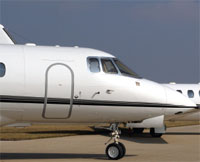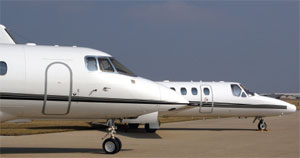
Sky Raiders
High-traffic airport installs security system to help catch thieves on land and in air
 Today’s airports are at the frontline of homeland security.
Checking for shoe bombs, banned liquids and
suspected terrorists are part of the daily routine for
airport security personnel. In fact, airport vulnerability
has become such an issue that the Department of
Homeland Security assigns the airline industry its own threat
level designation. For example, airports can be assigned to
threat level orange, meaning “High Risk of Terrorist Attacks”
while the rest of the nation is at yellow, or “Elevated Risk.”
Today’s airports are at the frontline of homeland security.
Checking for shoe bombs, banned liquids and
suspected terrorists are part of the daily routine for
airport security personnel. In fact, airport vulnerability
has become such an issue that the Department of
Homeland Security assigns the airline industry its own threat
level designation. For example, airports can be assigned to
threat level orange, meaning “High Risk of Terrorist Attacks”
while the rest of the nation is at yellow, or “Elevated Risk.”
As important as they are, terrorist threats are not the only
concern of an airport’s security mandate. Airports are highly
complex facilities that sprawl over very large areas. They have
millions of visitors who come and go freely every year. They
never close, and highly valuable assets are found everywhere.
Potential security events can happen almost anywhere and at
any time.
The security concern that led a major Florida general aviation
airport to upgrade its surveillance system was theft. For
some time, thieves were gaining unauthorized access to planes
parked on airport grounds and stripping them of expensive
equipment such as radio communications, navigation systems
and GPS systems.
Looking Up
At first, security officers thought that the
culprits accessed the airfield by car. In
response, they focused on improving their
surveillance system at vehicle access
points. However, when the thefts recurred,
they realized that the thieves were intruding
by another means. For this, they had to
look to the sky.
Airport security authorities soon realized
that thieves were landing on the airfield,
stripping target planes and then taking
off again with the stolen equipment.
The airport in question (which cannot be
disclosed for reasons of confidentiality)
did not have an efficient way of tracking
every aircraft using the airport.
Additionally, it was not feasible to implement
systems or procedures to do so, especially
when the thefts typically occurred at
night, when airport use was lowest.
Airport operations staff instead decided
to adopt a surveillance solution to
address the problem of theft from parked
aircraft. The strategy was to set up a system
that would provide the video evidence
necessary to convict thieves. To achieve
this, security officials turned to systems
integrator SiteSecure, a PSA member firm
in Sanford, Fla.
Although it seemed simple, SiteSecure
found a technically complex project on
their hands. The project called for surveillance
video that would record the movements
of all aircraft using the taxiways for
take-offs and landings. This meant that the
video footage would need to have sufficient
resolution to capture identifying
details, such as the aircraft model and
alphanumeric registration identifications
on the planes.
Hard Evidence
Among the main challenges to overcome
in achieving these security objectives were
distance, darkness and power. The airfield
locations requiring surveillance were
approximately a quarter mile from both
the beacon tower (the highest point on the
airfield that could be used for wireless
communication) and administration building,
where the video would be recorded
and viewed.
“Airport officials and consultants originally
designed the system to position
cameras near existing power sources,
which required telephoto lenses to see the
taxiways. But capturing high-resolution
images from a quarter mile away becomes
expensive and technically challenging at
that distance, especially at night,” said
Andy Bowman, PE, of SiteSecure. “The
best-quality images come from a closer
range, and because our client wanted identification-
level surveillance, that’s where
we went.”
By definition, identification-level
video produces images that enable positive
identification of an object, typically a
person or a vehicle. Identification-level
video is irrefutable and is considered concrete
evidence in a court of law.
Identification-level video, or CCTV
surveillance, is achieved by using a highresolution
camera in combination with a
carefully selected lens. The focal length is
crucial when designing for identificationlevel
video; too wide a lens will result in
the loss of identifying detail while too narrow
a lens may risk missing critical
events. Capturing identification-level
video requires the right balance between
detail and coverage area.
Although capturing identification-level
video is challenging enough during the
day, doing so at night can turn into a technical
minefield without the right tools. To
ensure consistent, reliable identificationlevel
video during dark hours, SiteSecure
selected Extreme CCTV’s EX30 infrared
imagers with onboard active-infrared illumination.
IR lighting is an important factor
in providing nighttime illumination, as
ambient flood lighting interferes with airfield
lighting and signalization.
Furthermore, the all-weather EX30 is
equipped with an IR-corrected 5- to 50-
millimeter varifocal lens, allowing maximum
versatility in focal range and crisp
focus both day and night.
Active-infrared is technology that uses
“invisible” light of slightly longer wavelengths
than visible light. IR-sensitive
cameras use this invisible light to form
high-resolution video images that resemble
normal black and white images taken
during the day. Because they do not rely
on heat differentials the way thermal cameras
do, they are capable of producing
high-resolution images with identifying
details, including alphanumeric lettering
and facial features.
“Although many of today’s day/night
cameras can get some video signal from
dark areas, they are not reliable enough
for positive identification,” Bowman said.
“To get the high-performance video our
client wanted while avoiding interference
with aircraft navigation, we had to use
active-infrared.”
Having selected the right technology,
Bowman then had to address power and
video transmission—two challenges that
required the best of SiteSecure’s design
engineers.
“There are no readily available power
sources or pathways for video cabling
near the taxiways,” Bowman said. “And it
was not economically feasible to trench
power and fiber-optic cabling to all of the
camera sites.”
Given this set of challenges, Bowman’s
team designed an innovative integrated
package that would solve both problems.
Power and Video, Unplugged
SiteSecure combined a wireless video
encoder system manufactured by Verint
and a solar-driven power supply manufactured
by Solis Energy that operates independently
of hard-wired power. Together,
the system uses solar power alone, incorporating
a deep-cycle battery array that
provides uninterrupted power to the cameras
and transmission equipment, even
through three days of cloudy weather.
Solis Energy, located in Florida, specializes
in custom solar solutions for the
IP technology industry. The company’s
product line includes an outdoor UPS that
can be connected to a variety of AC power
sources to provide a continuous power
supply for devices like cameras, wireless
access points and other low-voltage solutions.
Several UPS modules also were
used in places where a 120-volt circuit
was available nearby.
The solar and UPS systems would
need to power not only the EX30 infrared
imagers, which were selected for the low
12-volt DC power consumption, but also
the wireless video transmission equipment. The Verint S1100w transmitters,
which are devices that combine MPEG-4
encoder technology with a digital wireless
transmitter that can use the 2.4 or 5 GHz
spectrum for wireless transmission, may
be deployed in a point-to-point or pointto-
multipoint configuration, which
reduces the total amount of equipment on
the project.
The airfield cameras transmit live
video to the airport’s beacon tower, where
it is received and re-transmitted to the airport’s
operations center.
All of the airfield cameras, regardless
of their location, are received at the operations
building by a single Verint S3100
wireless receiver, which in turn is connected
to a dedicated TCP/IP security network.
The network serves as the backbone
for a Genetec Omnicast network
video management system, which records
and manages video from the airfield cameras.
This software platform is an openarchitecture
system that is loaded on an
HP ML series server with 2 Terabytes of
internal storage.
Using this system, the airport operations
staff can access both live and recorded
images from any computer across the
entire network, drastically increasing their
ability to respond to security issues.
“The old system was inflexible.
Operations staff would need to be at specific
computers in order to view and
respond to security events,” Bowman said.
“Under the new system, operations staff
can now access the security system from
almost any computer on the network,
greatly reducing their response times and
allowing them to quickly deploy the
appropriate corrective measures.”
Improved Response
Results from the system have been positive.
Using an LXR CCD sensor that
delivers high spectral response to infrared
illumination, the EX30 infrared imagers
are able to capture crisp, high-resolution
images of the plane registration numbers
day and night. Active-infrared at night has
become critically important. Without
active-infrared, images either lack the
sufficient amount of light necessary to see
the numbers or the camera switches to
frame integration mode, causing the numbers
to blur.
Airplane registration numbers, which
vary in size, contrast and location on the
aircraft, act like license plates for planes.
An image showing an airplane’s registration
number positively identifies it and can
serve as irrefutable evidence. Also, an aircraft’s
registration number allows airport
security to gain a wealth of information
about the plane’s registered owner.
“Since our integrated system was
installed, the airport has significantly
improved their response to security and
malicious activities,” Bowman said.
Within the first month of service,
video evidence was archived to a CD and
transmitted to the local police department
for investigation of a recent theft. The
system illustrates how a seemingly complex
security project can be easily
addressed with the right products and the
right integration.
“The airport originally allocated too
much money to the project,” Bowman
said. “We were able to complete the job
and deliver the results for a lower project
budget. It’s just a matter of using the
right technology and
making it all work
together.”